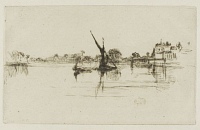The Little Putney | ||
| Number: | 187 | |
| Date: | 1879 | |
| Medium: | etching and drypoint | |
| Size: | 124 x 201 mm | |
| Signed: | butterfly at lower right (2-final) | |
| Inscribed: | no | |
| Set/Publication: | no | |
| No. of States: | 3 | |
| Known impressions: | 23 | |
| Catalogues: | K.180; M.177; W.226 | |
| Impressions taken from this plate (23) | ||
KEYWORD
architecture, barge, boat, bridge, building, landscape, river, tree.
TITLE
A certain amount of confusion in naming and numbering this etching has occurred, as in the following examples:
'The little Putney' (1879, Whistler). 1
'The Little Putney' (1879, possibly Whistler). 2
'Putney: Number Three' (1886, Frederick Wedmore (1844-1921)). 3
'The Little Putney (No. 3)' (1893, Chicago). 4
'Putney: No. 3' (1900, Caxton Club). 5
'Little Putney: No. 2' (1905, ISSPG). 6
'The Little Putney, No. 2' (1909, Howard Mansfield (1849-1938)). 7
Whether it is 'No. 2' or 'No. 3' partly depends on whether the large Old Putney Bridge 185 is considered 'No. 1', in which case the two small etchings of Putney, this and Little Putney Bridge 186 would be '2' and '3'.
If only the 'Little Putneys' are counted, then there are just two. Thus, this was called 'The Little Putney, No. 2' by Mansfield and Kennedy.
A simple solution is to call this, which does not show the bridge, 'The Little Putney' (as suggested by Whistler) and the other small view, which does include the bridge, Little Putney Bridge 186.
'The little Putney' (1879, Whistler). 1
'The Little Putney' (1879, possibly Whistler). 2
'Putney: Number Three' (1886, Frederick Wedmore (1844-1921)). 3
'The Little Putney (No. 3)' (1893, Chicago). 4
'Putney: No. 3' (1900, Caxton Club). 5
'Little Putney: No. 2' (1905, ISSPG). 6
'The Little Putney, No. 2' (1909, Howard Mansfield (1849-1938)). 7
Whether it is 'No. 2' or 'No. 3' partly depends on whether the large Old Putney Bridge 185 is considered 'No. 1', in which case the two small etchings of Putney, this and Little Putney Bridge 186 would be '2' and '3'.
If only the 'Little Putneys' are counted, then there are just two. Thus, this was called 'The Little Putney, No. 2' by Mansfield and Kennedy.
A simple solution is to call this, which does not show the bridge, 'The Little Putney' (as suggested by Whistler) and the other small view, which does include the bridge, Little Putney Bridge 186.
1: Written on .
2: Etched on the plate in the third state; see Mansfield 1909[more] (cat. no. 177).
3: Wedmore 1886 A[more] (cat. no. 226).
4: Chicago 1893 (cat. no. 2242).
5: Chicago 1900 (cat. nos. 196, 196a).
6: London Mem. 1905 (cat. no. 226).
7: Kennedy 1910[more] (cat. no. 180).
DESCRIPTION
On the right is a large two-storey building with a triangular pediment on the bank of a broad river, with an iron pier in front of it, at which a barge is moored. The bank beyond is wooded, with occasional houses. In the river is a small sailing barge with furled sails, and two smaller barges or lighters beside it. At far left a jetty or boat projects from the bank of the river. There are slight indications of reflections in the water.
SITE
The River Thames at Putney in London. The area has been extensively developed and this exact site has not been identified, although it seems likely that Whistler was working from a raised viewpoint, possibly from old Putney bridge. There is now a substantial pub, the Star and Garter, on the bank upstream from the bridge, which may have replaced the neo-classical building (since the view is as usual reversed in the print, the two-storey building was actually to Whistler's left).
